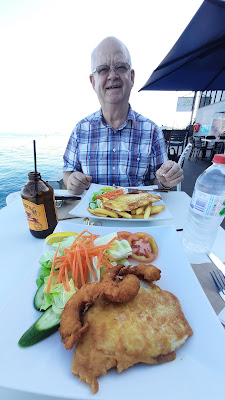It must be time for another update of newsfromjude, so I will try to get our time in Darwin into some sort of order for a post.............
First I will include a bit of Darwin history from the internet.........
The harbour of Darwin was discovered in 1839 and was named after British evolutionist Charles Darwin. The Overland telegraph was constructed between South Australia and Darwin from 1870 to 1872. In 1871 a 1100 mile submarine cable between Darwin and Java was laid. This in turn was connected to Singapore, Europe and London.
Originally the Northern Territory was a part of South Australia, but was separated to Commonwealth control in 1911.
Aviation has played a significant part in Darwin's history. Ross and Keith Smith landed here to achieve the first flight from England to Australia in 1919. As early planes struggled with the distance from Europe, Darwin became a vital stopover airport.
At the beginning of WW11 Darwin only had a population of 2000 and was extremely isolated with a small airport, unsealed roads to the rest of Australia and little infrastructure.
The bombing of Darwin by Japanese forces has had a lasting effect on Darwin, both in the destruction caused and the massive build up of the area by allied forces.
To aid the war effort, the road to Alice Springs was upgraded and sealed, large military airports were built at Darwin and Batchelor and many smaller airfields were built. Adelaide River developed as an important strategic military base with ammunition dumps, supply depots and a hospital. The railway was strengthened to handle a massive increase in traffic and the rail bridge was decked to provide a wet season crossing for road traffic.
And the biggest change was delivered in a few hours by Cyclone Tracy in 1974 when the existing town was nearly completely destroyed. Many of the victims of the cyclone are buried at the Darwin General Cemetery and a visit can drive home just how much this destruction affected peoples lives. However the rebuilding that followed has left a well designed, modern city very few old buildings.
***********************************************************************
Driving into Darwin and following the signs................
The Darwin Military Museum is located at East Point
The site is within a heritage listed area that contains WWII fortifications. The No.2 gun turret is located within the Military Museum and, along with the No.1 gun turret, is one of the major fortifications at East Point.
This is a concrete base for Anti-aircraft gun and is on the shore at East Point Darwin......... This is facing the sea, and to watch for any attack from that direction, but apparently they were surprised by a Japanese attack which came from behind, and caught them unprepared!!
The Darwin Aviation Museum, located in Winnellie, Darwin, houses an impressive collection of the Territory's aviation history and reminds us of Darwin's frontier role in World War II.
A massive B52 Bomber dwarfs other exhibits, including Mirage and Sabre jets, a Spitfire replica, Orion P3-C, Wessex and Huey Cobra helicopters. Other exhibits include engines and armament as well as many photographs of Darwin at war, pioneer flights and record breakers. The development of the jet age is also depicted through displays and photographs.
There was a film depicting the flight of Ross and Keith Smith and early pioneers of flight.
There were several places where you could sit and view films about war events, as well as the first flights from London to Darwin. The film of the bombing of Darwin was very confronting and showed just how close Australia came to be taken by the Japanese.
We also toured through the WW11 Oil Storage Tunnels. These were built during WW2 by the Civil Construction Corps to protect Darwin's oil supplies from the Japanese bombing raids. However by the time they were completed, the risk had ended and were never used to store oil. They were reopened in 1992 to commemorate the 50th anniversary of the Bombing of Darwin. They are located beneath the cliffs of Darwin city.
There are many places around the city that acknowledge the WW2 heritage of Darwin.




























































4 comments:
I like the place where you ate along the warf.
Deana at dreamworthyquilts.blogspot.com
Lovely place to eat at the wharf Jude. We ;earnt about the bombing at school in NZ, I am surprised you didn't here. Lots of interesting places to go and see - I am hopeful of getting to Darwin one day.
so looking forward to checking out Darwin in a few months........
The WWII museums are really interesting, aren’t they. They Btw is enormous. We didn’t worry about going through the tunnels. We were surprised that there wasn’t more information about the cyclone and had to hunt out the tiny museum at the art gallery. Stokes wharf is a lovely pl e to enjoy a leisurely lunch.
Post a Comment